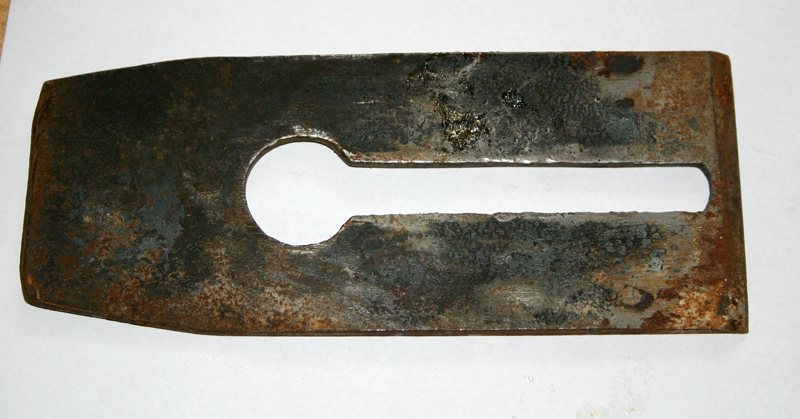I was recently very fortunate to win an A5 (post war) on an EBay auction...
From the outset I should say that I want to use this and not 'collect' it. Looks are secondary but...
Previous owners have already sanded the engine-machining off 80% of the sides (shame but I think it may have been quite severely rusted at some point (still stains on the sides). Would you complete the job and bring it back to bright metal now that the damage is done?

Note the engine turning to front of plane - the last vestiges! It looks like the plane has been heavily sanded at some stage...

Anyway, my question (and I admit my ignorance here - so be gentle...)
The plane iron is stamped Norris and is 182mm long (it looks to have plenty of length(?))

The (unmarked) cap iron has a distance of 58mm from centre of screw to tip (I think this is the relevant dimension to my question)

When inserted in the plane, I have to have 4mm of blade protruding past the cap iron - or I run out of adjustment (inwards)
At some point in the past, the blade has been filed to elongate the slot, and the cap iron is mounted towards the end of the slot (i.e. own towards the cutting edge)
My failing logic tells me that either he blade is too long or the cap iron too short - although I have pondered if the converse is true and the blade is at end of life....
However, it still produces very fine shavings....

All advice (or measurements of another A5) or any help gratefully received.
Liam
PS I blame Jimi and gasman (Mark) and the rest of you for collectively sending me down the infill path... I was quite happy with my Cliftons up until now.... and having tried one (an infill), it feels like a one-way very steeply sloping street.... I have even started making one...
From the outset I should say that I want to use this and not 'collect' it. Looks are secondary but...
Previous owners have already sanded the engine-machining off 80% of the sides (shame but I think it may have been quite severely rusted at some point (still stains on the sides). Would you complete the job and bring it back to bright metal now that the damage is done?

Note the engine turning to front of plane - the last vestiges! It looks like the plane has been heavily sanded at some stage...

Anyway, my question (and I admit my ignorance here - so be gentle...)
The plane iron is stamped Norris and is 182mm long (it looks to have plenty of length(?))

The (unmarked) cap iron has a distance of 58mm from centre of screw to tip (I think this is the relevant dimension to my question)

When inserted in the plane, I have to have 4mm of blade protruding past the cap iron - or I run out of adjustment (inwards)
At some point in the past, the blade has been filed to elongate the slot, and the cap iron is mounted towards the end of the slot (i.e. own towards the cutting edge)
My failing logic tells me that either he blade is too long or the cap iron too short - although I have pondered if the converse is true and the blade is at end of life....
However, it still produces very fine shavings....

All advice (or measurements of another A5) or any help gratefully received.
Liam
PS I blame Jimi and gasman (Mark) and the rest of you for collectively sending me down the infill path... I was quite happy with my Cliftons up until now.... and having tried one (an infill), it feels like a one-way very steeply sloping street.... I have even started making one...






































